- Home
- New Kyurizukai
- Study of Marine NaturalProduct Chemistry
from Keio's Faculty of Science and Technology
Study of Marine NaturalProduct Chemistry
from Keio's Faculty of Science and Technology
Unique and new compounds
derived from nature
I owe what I am today to my respected teacher
Discovering one unknown substance after another from marine cyanobacteria, Dr. Suenaga endeavors to approach and elucidate the usefulness of such substances. He has inherited his preparedness both as a researcher and educator to his respected teacher whom he encountered as a university student. Once a young student lacking an interest in chemistry, why and how did he become bent on the exploration of unknown substances?
Kiyotake Suenaga
Dr. Suenaga’s specialty is marine natural product chemistry. He is engaged in exploration of biologically active substances. Currently, his focus is on marine cyanobacteria. In 1992, he was enrolled in Nagoya University’s Graduate School of Science. In 1995, he left the doctor’s course to become a research assistant for the Department of Chemistry, Faculty of Science of the university. In 1997, he acquired a doctor’s degree (in science). After serving as a research assistant for Shizuoka Prefectural University (Pharmaceutical Department) then as an assistant professor for the University of Tsukuba (Department of Chemistry), in 2006 he assumed the current position as an associate professor for Department of Chemistry, Keio University Faculty of Science and Technology. Dr. Suenaga was honored with the Inoue Research Award for Young Scientists in 1998 and the Chemical Society of Japan Award for Young Chemists in 2003.
Introducing Researchers
Featured in this issue is Associate Professor Kiyotake Suenaga, whose research focuses on exploration of unknown substances from marine organisms.
Unknown substances from marine organisms are intriguing
Accelerating research for application to pharmaceutical development
How many substances are there on our earth? Associate Professor Kiyotake Suenaga of the Natural Product Chemistry lab makes an almost endless pursuit of unknown substances available from marine organisms, saying: “There must be an incredibly large number of effective substances yet to be discovered.” A recent example of his discoveries is a substance isolated from cyanobacteria. It has been found that this substance has an action that is expected to be used for remedies against cancer and osteoporosis, thus opening up the possibilities of application for pharmaceutical development.
The beginning of the quest for unknown substances
A beach in Okinawa in May . . . A group of people, each wearing a longsleeved shirt and a hat, was found intently looking for something under the glaring sunlight. This group was Associate Professor Suenaga and his students collecting marine organisms. The quest of unknown substances begins with an incredibly exhaustive work of gathering potential materials (Fig. 1). Since Dr. Suenaga transferred to Keio University in 2006, he has been mainly collecting marine cyanobacteria. Cyanobacteria are a type of bacteria that have chlorophyll and perform photosynthesis. They are believed to have produced oxygen in the primeval times of the earth. Dr. Suenaga says that he chose cyanobacteria as his objective not because he felt special potential in cyanobacteria. “I had no particular theoretical reason for choosing cyanobacteria as my objective. No one knows that an exciting substance can be found in a particular organism,” remarks Dr. Suenaga. Indeed, assumption is a taboo when it comes to exploration of unknown substances. He continues: “If I dare to give a reason, it’s perhaps because cyanobacteria were attached to seaweeds which were the food of sea hares I was studying as a college student.” Sea hares are known to have a unique substance, which is considered to be their food origin. That’s why cyanobacteria have weighed on his mind since then.
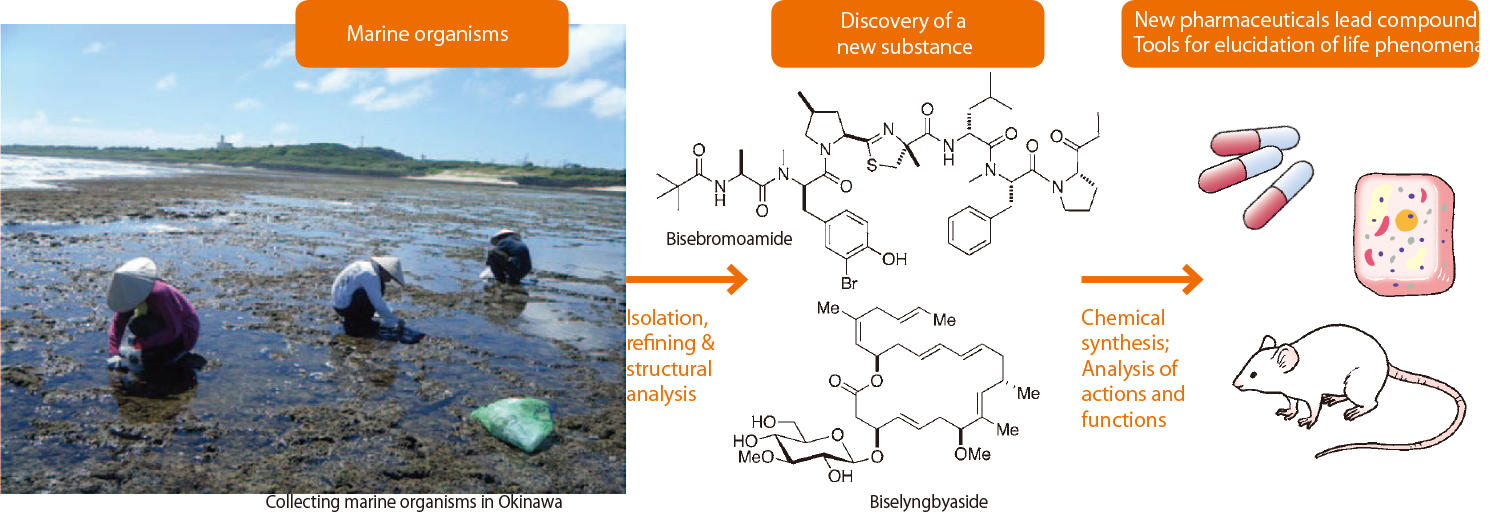
Fig. 1 Marine natural product chemistry
Some marine organisms contain substances that have a unique chemical structure and bioactivity unavailable from terrestrial organisms. Discovery of such substances is extremely important, not merely as discovery of new substances, but also because they can contribute to pharmaceutical development and shed light on living phenomena.
Anticancer activity as a bench mark
The total amount of cyanobacteria that has been gathered in the past five years is approximately 150 kilograms, from which essence is extracted, allowing a “target” substance to be isolated. Isolation is a process of purifying (Fig. 2), making full use of chromatography*1 and other sophisticated techniques in the state where no substances other than the target are mixed. The bench mark for Dr. Suenaga to choose a target is whether the substance in question has an anticancer activity *2 or not. Therefore, most of the substances Dr. Suenaga has chosen thus far have an anticancer activity.
Then he proceeds with the examination of the target substances based on their chemical structures. Use of a nuclear magnetic resonance spectrometer (NMR) installed at the Keio campus enables a substance’s chemical structure to be identified in a short period of time. If the chemical structure of a given substance is too complex, an NMR with higher resolution, available outside the campus, may be used. More specific aspects of the substances are determined based on their reactivity and crystal structure analysis. Once the structure has been identified, you can determine whether the substance is really unknown.
Bisebromoamide was the first substance discovered from an extract of cyanobacteria through such an exploration process. “We named it ‘Bisebromoamide’ because it was an amide containing bromine (Br) and found in cyanobacteria which were gathered in the seaside Bise district of Okinawa,” says Dr. Suenaga. He makes it a rule to give a substance he has discovered a name based on the place of discovery and/or the main characteristic of its molecule. Bisebromoamide was successively followed by the discovery of biselyngbyaside and leptolyngbyolides. And even a fourth substance is likely to be discovered before long.
That said, each of these substances is available in only an extremely small amount (several milligrams to several tens of milligrams). This makes it difficult to make detailed investigation into properties and actions of these substances. As a solution to obtain sufficient amount of substances, Dr. Suenaga is attempting artificial chemical synthesis. Synthesis methods for bisebromoamide and biselyngbyaside are expected to be established soon.
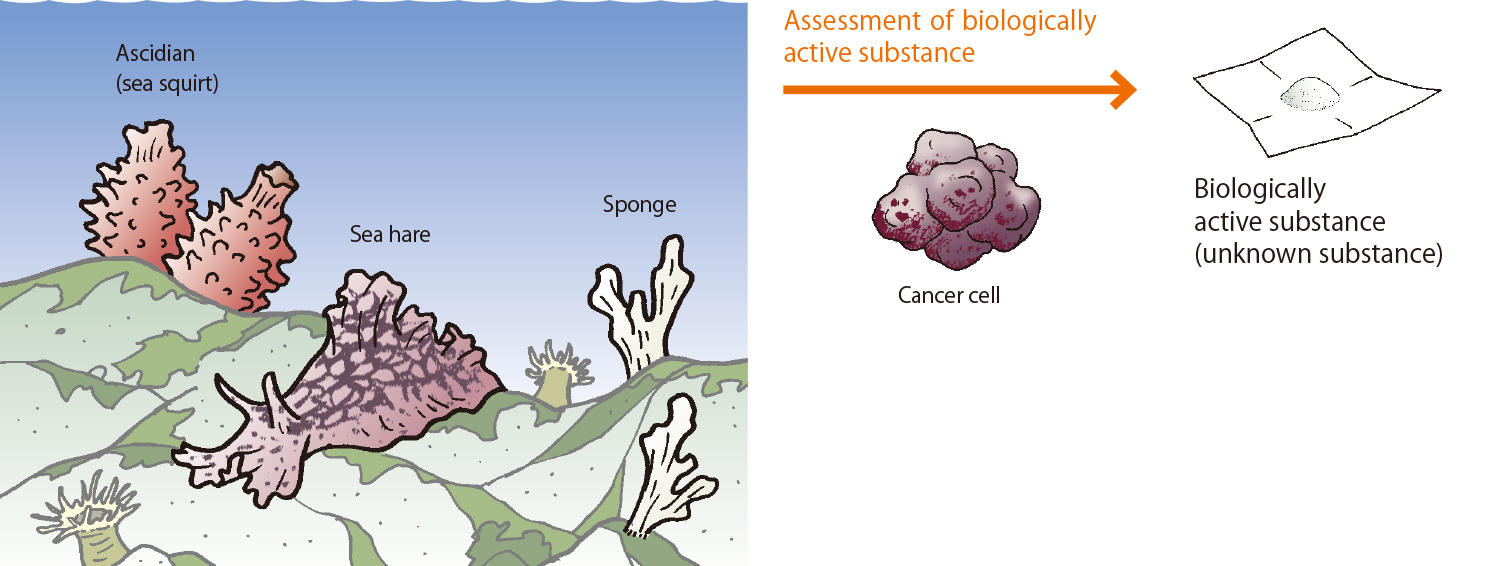
Fig.2 Exploration of biologically active substances
Biologically active substances derived from marine organisms are available only in extremely small amounts, making it difficult to isolate the target substance by purifying extraction materials by ordinary means. However, it is possible to isolate the target substance even from a very small amount if we use biological activity as a bench mark. You may compare it to ants that can locate sugar, attracted by its sweetness.
Key points for successful research
Dr. Suenaga’s research work now appears to be progressing smoothly. But he could not find any promising substance at all in the first two years. There are countless marine organisms. Why didn’t he switch to other organisms? “To tell the truth, I had been dealing with other marine organisms in my early years, but I couldn’t achieve visible results. That’s why I switched to cyanobacteria. Therefore, the idea of giving up cyanobacteria in a mere two years or so didn’t occur to me at all.” It seems that exploration of unknown substances also requires tenacity and toughness.
A turning point came to him when he began collecting cyanobacteria of different varieties from what he had been focusing on. “When talking about cyanobacteria, we tend to think, first and foremost, of those outstanding ones like impressive green algae. Having spent two years looking only at cyanobacteria, however, I suddenly noticed that cyanobacteria also exist that are plain and less conspicuous,” he remarks. This change in approach fueled his advance.
Substances derived from marine organisms: a focus of attention
“Among the many substances I know, bisebromoamide is unique in that it contains D-amino acid, bromine (Br) and t-butyl group.” Substances derived from marine organisms are intriguing not merely because of their structures. Dr. Suenaga continues, “Recently I’m often asked by researchers of my acquaintance, ‘Do you have any interesting substance?’ So I send a sample. Later on, I receive a report from that researcher saying that he/she found a particular action.” For example, Prof. Je-Tae Woo of Chubu University informed him of the possibility that biselyngbyaside might become an effective remedy for osteoporosis.
Osteoporosis is a disease for which no effective remedy has been found to date. So biselyngbyaside has come to the fore as the key substance for an osteoporosis remedy. Dr. Suenaga humbly says, “Although I can gather and isolate unknown substances, I’m not in an environment where I can examine all of them in detail as to what actions these substances have. So I really appreciate other researchers’ efforts and support in this regard.” Despite his humble comment, it may not be an exaggeration to say that such a co-research framework can exist only because the substances discovered by Dr. Suenaga have been intriguing enough.
On March 23, 2011, the Chemical Daily ran an article reporting that fullscale pharmaceutical development endeavors would be undertaken using the substance discovered by Dr. Suenaga. Adding “Pharmaceutical development requires the highest possible safety and efficacy,” he appears to be not placing too much expectation on the proposed phar maceut ica l de velopment and is determined to steadily pursue his research work. Yet, at the same time, he proudly says “Should it fail to come to fruition as a new drug, the significance of continuing in-depth quest of unknown substances remains unchanged because it will eventually help to shed light on mysteries of life phenomena.”
“Many marine organisms have no shells to protect themselves and are slow in moving, making them apparently defenseless. Despite that, they are surviving. Decades ago, some scientists thought that such organisms must have a certain kind of defensive substance that enables them to survive despite their apparent weakness. This is believed to be the starting point of exploration of unknown substances peculiar to marine organisms. I’m not sure if this hypothesis is true or not, but as far as my research endeavors are concerned, I can confidently say that marine organisms do have many intriguing substances that are not yet known to us,” concluded Mr. Suenaga. Natural product chemistry is bound to attract more and more attention in the years to come.
Interview
Listening to what Associate Professor Kiyotake Suenaga has to say
An encounter with a great teacher
How did you spend your childhood?
I was born in Aizu in Fukushima Prefecture and raised in Sendai in Miyagi Prefecture. Since I grew up in a leisurely,stress-free environment, there was nobody who attended a cram school. Also, I was never told by my parents to study hard. So until I graduated from junior high school, I had rarely studied at home.
As a small boy, I thought to myself that I would find employment with the Japan National Railways (now JR) in the future. For me this seemed to be a natural course of life since three generations of my family, from my grand-grandfather to my immediate father, had worked for the National Railways. So I was raised in official National Railways housing. The fact is, my father was one of the first-generation drivers of the Tohoku Shinkansen SuperExpress. When I was an elementary school boy, my father was studying hard to become a Shinkansen driver to prepare for the Tohoku Shinkansen line opening, which I still remember. My own son appears to respect his grandfather much more than his father (myself) because he has no idea about what I’m doing.
What was the impetus for you to make a decision to specialize in chemistry?
I was once reaching for the universe. In fact, my interest had been in physics rather than chemistry until I became a university student. But by the time it was time for me to choose a lab to study in, my interest had shifted to natural products and other complex substances. At Nagoya University in those days, however, studying in the organic chemistry group of the Graduate School of Chemistry required a kind of resolution. It was because there were two professors’ labs available – Prof. Ryoji Noyori who was later to win a Nobel Prize, and Prof. Kiyoyuki Yamada, my teacher, both famous for being very strict. I finally decided to join Prof. Yamada’s lab.
What was the atmosphere of your lab?
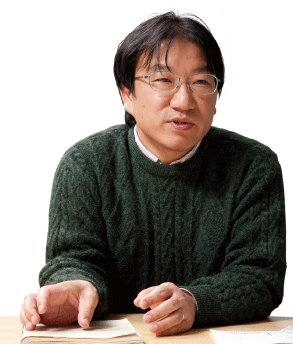
As a newcomer, I had no idea of what the Yamada lab was like, but soon I found that the lab was with great traditions. Dr. Yoshimasa Hirata, the predecessor and teacher of Dr. Yamada, is famous worldwide for his research on tetrodotoxin (globefish poison). Furthermore, Dr. Osamu Shimomura, awarded the 2008 Nobel Prize in Chemistry for his research into green fluorescent protein found in jellyfish, had once studied in Dr. Hirata’s lab. By chance, I put myself in an environment that is one of the greatest centers of natural product chemistry. Even today, I make it a rule to introduce my respected teacher Dr. Yamada’s research work “Carcinogenic Substance of Bracken” at the beginning of the “Chemistry of biologically active molecules” class work for juniors of the Department of Chemistry. Bracken was known to cause livestock poisoning and study of this problem had been undertaken since the 19th century mainly in Europe. In this process, it came to be known that bracken has carcinogenic property, which drove many researchers around the world into competing with each other to identify the culprit. However, the carcinogenic substance could hardly be captured because it is very unstable and sensitive and because a simple biological test method as a guide for extraction and separation could not be established for years. Finally Dr. Yamada identified the substance by inventing a moderate extraction separation method after conducting carcinogenic tests untiringly – a process that took many years and required a large quantity of extraction samples. Apart from being my teacher’s achievement, this study is a wonderful research work that is sure to find a place in history. In this connection, let me add one point: his work also made it clear that bracken can be eaten safely if it is cooked because the carcinogenic substance is completely decomposed when cooked.
Starting a researcher’s life
What was the first research work in your life like?
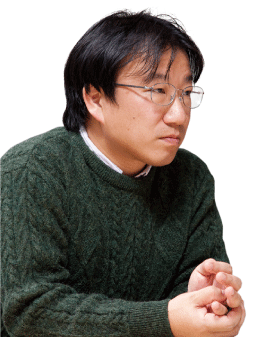
My first research theme was chemical synthesis of Aplyronine A. This substance can be obtained from sea hares, a marine organism that looks like a large slug. Aplyronine A is an anticancer substance discovered by the Yamada lab. It interacts with actin, the knowledge of which was quite innovative in those days. I came within an inch of success by the end of the second year of the master’s course. But the last reaction would not take place, which put me at the end of my rope after all. Reluctantly, I had to go far back to a substance of the early stage and rebuild the synthesis method. I was like a climber who reached the ninth stage of a mountain but was suddenly pulled back down to the third stage. Even so, I remained steadfast, thinking I should not abandon the project halfway. It was at the end of the first year in the doctor’s course that I finally succeeded in the synthesis. Incidentally, Dr. Hideo Kigoshi (University of Tsukuba), a disciple of Dr. Yamada, has taken over the research into the substance’s action mechanism. At a recent academic meeting I had an opportunity to listen to Dr. Kigoshi’s lecture that mentioned a new development in the study of the action mechanism. Completion of the Aplyronine A synthesis urged me to ask Dr. Yamada for permission to isolate it and determine its structure myself. It had been my wish to do the task if I had advanced to the doctor’s course. I wanted to find a new substance on my own instead of synthesizing something that has been isolated and structure-determined by someone else. Dr. Yamada told me right away, “Isolate it yourself.” I felt that my teacher must have known my wish before I put it into words. In those days, there was a substance from the sea hare Dollabella auricularia that was too hard to capture. Though the substance had a very strong activity, the amount available was extremely small. Using an extract equivalent to 250 kilograms of the sea hare, I patiently repeated the isolation process over and over again and finally obtained about 0.5mg of substance called Aurilide. It was one of the smallest amounts among the substances I had ever obtained. I used that sample to conduct two kinds of experiments for structure determination and consumed all of the natural Aurilide. The experiments strained my nerves. Once its molecular structure was identified, it was possible to synthesize the substance. I synthesized about 1.5 grams of it and conducted experiments on animals to verify its anticancer properties. But this substance could not be developed into a pharmaceutical because of toxicity.
You’ve had a number of significant experiences since your student days, haven’t you?
Actually, I was already a research associate by that time. I quit the doctor’s course in February of the first year to fill the research associate’s post because the former research associate transferred to another lab as an associate professor. Whether willing or not and given little time to think about my future, I found myself hastily starting a researcher’s career.
Putting much importance on time for communicating with family and students
Your research work seems to require great endurance.
What are you doing for diversion?
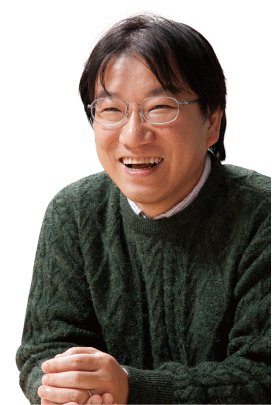
My hobby is listening to music. Soon after joining the university, I began going to concerts in and around Nagoya. At one time, I went to concerts 50 to 60 times a year. Do you know there are nine professional orchestras in Tokyo? It’s an exceptional boon to classical music enthusiasts like me. I’m a subscriber of the Tokyo Symphony Orchestra. Yesterday I went to a concert by the NHK Symphony Orchestra. At some concerts, childcare services are even available, which allows me to place my small sons (aged 6 and 3) under childcare. Sometimes I take my 9-year-old daughter to concerts, but she often sleeps during the performance. I think it’s OK because I frequent concerts for my own pleasure (laughter). Anyway, enjoying music is truly refreshing. I’m also trying to spare as much time as possible for communicating with my children. It’s my rule to eat breakfast and dinner with my small ones. Since my home is close to the campus, I go home for dinner and take care of their bathing, then go back to the campus again for work. Being with children is another diversion for me.
What a wonderful papa! How are you dealing with your students?
You may call me a strict teacher. Every week we have one rinko session where lab students take turns reading a textbook written in English, a magazine meeting where students introduce scientific journals they have read, and a study meeting where they learn about instrumental analysis. Of the over ten lab students, five take charge of such meetings every week, meaning that one student will take charge of one meeting every two to three weeks. This is a rather heavy burden on the students as it requires significant amount of preparatory study.
Experiments are one important thing, but there is another more important thing; I would like my students to build up their academic capability by learning broadly. Concerning our specialty, I’d like them to acquire comprehensive knowledge of organic chemistry. Suppose a student who is engaged in isolation and structural determination lacks knowledge of organic synthesis reactions, or a student who is focused on synthesis of a natural product knows nothing about biosynthesis. I don’t want my students to be like that.
Looking back at myself, I was thoroughly educated during my student days. In those days, we were not allowed to cut corners in experiments for the sake of learning at the desk. So it was often the case that I studied at the desk while completing preparations on the testing bench so a reaction would take place. A research report meeting was scheduled on one Monday but my experiment conducted on Friday of the preceding week didn’t go well, which annoyed me. At the time, one of my seniors said, “Have you ever thought about why a research report meeting is held on Monday?” I understood his suggestion was that I should do the experiment over the weekend. I don’t say such a thing to my students, but our lab’s study meeting held on Saturday may be because of that experience during my student days. In retrospect, many of the tough experiences I had as a student are now proving to be assets for me. A friend of mine who found employment with a private company says the same thing.
Just a word from . . .
Student M : I have an unforgettable memory. Due to our mistake or other reason, we knew that our reservation for rooms at a family-run inn in Tokunoshima Island was not made. In the gathering dusk, I solicited the inn to provide us with two rooms (connected) somehow or other and finally secured the rooms. Even under such circumstances, we energetically gathered cyanobacteria as we normally would. Our teacher’s power is always a driving force for us students.
Student N : I joined this lab because it has been my wish to create a variety of substances by using organic chemical reactions. I’m happy and comfortable here because I’m allowed to do almost whatever I want. When I’m in trouble, my teacher thinks together with me and is willing to listen to my proposals.
(Reporter & and text writer: Akiko Ikeda)


